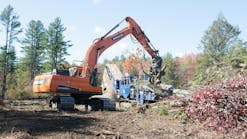A specially outfitted Case CX160 excavator adapted for hazardous duty will allow the United States Navy to dig for unexploded ordnance and other hazardous materials at a site in Virginia – by remote control.A team including Virginia Polytechnic Institute and State University, Texas-based National Instruments Corporation, the Navy, and Case modified the CX160 for this special assignment. The CX160 will be pressed into service at the Naval Surface Warfare Center in Dahlgren, VA, digging for surplus ordnance and other hazardous materials at a decades-old bomb-disposal site.
“The CX160 is well suited for this unique assignment,” remarks Bob Weiglein, a product manager with Case Construction Equipment. “The machine’s precision hydraulics and fine controllability will be put to good use by the Navy. We’re honored that Case was the excavator of choice for this project.”At a recent demonstration of the excavator’s new capabilities, an operator manipulated the machine’s two dual-axis joystick controls via the Internet while seated more than 1,000 mi. away from the CX160. National Instruments developed a software program called LabVIEW, which a team of Virginia Tech students modified so the excavator can be operated from a safe distance by remote control.Because the work is potentially hazardous, the machine operator will work from inside the safety of a shielded trailer 1,000 yd. from the excavation site. He will watch his work on video monitors linked to cameras onboard the excavator.Not much is certain about the types of explosives that were placed in the earth at Dahlgren, likely beginning about when the base opened in 1918. The policy of burying unexploded ordnance was halted in the mid-1950s, states George Clotfelter, the Navy’s lead engineer on development of the remote-controlled excavator.Dahlgren was established as the Naval Proving Grounds and named in honor of Rear Admiral John Adolphus Dahlgren, a man considered the father of modern naval ordnance.The 4,300-ac. facility on the Potomac River estuary has evolved into one of the Navy’s largest research and development centers within the US.“Munitions were buried in a number of sites around the base,” Clotfelter points out. “The remotely operated machine will allow us to safely excavate the site.”The Navy asked Virginia Tech to work on the project because the two have a long-standing relationship. Virginia Tech annually graduates engineers hired by the Naval Surface Warfare Center, and faculty from the university often teach classes at the base.Clotfelter was familiar with National Instrument’s LabVIEW software and called for its use when developing project specifications. White Oak Equipment Inc., a Case dealer in Fredericksburg, VA, that had rented a Case 9020B to the Navy for excavation of small-arms munitions on several earlier occasions, was the successful bidder that supplied the CX160.Al Wicks, a Virginia Tech professor of mechanical engineering who has taught graduate-level courses at the Dahlgren base, supervised the team of one graduate and five undergraduate students whose assignment was to adapt the excavator for remote control. Senior undergraduate engineering students at Virginia Tech are required to complete a projects class in which they create a product. In this case, a remote control system for the excavator was the focus of the class.To ensure that the excavator is running at capacity, the operator must monitor such systems as fuel level, water and oil temperature, and warning messages in real time. That information normally is visible on an onboard liquid crystal display. Case design engineers, in conjunction with their counterparts at Sumitomo Construction Machinery Company, developed software to report these data via an RS-232 port attached to the excavator’s standard onboard computer. The excavator can be monitored from any PC with either LabVIEW or a Web browser. Addressing safety concerns about operating a 110-hp excavator weighing more than 35,000 lb. by remote control was a major focus of the project. “The issue was how to make sure this thing doesn’t get away from us,” Wicks relates.To resolve the issue, an emergency shutdown system was developed using a line-of-sight radio link to the excavator that is separate from all other controls. If a continuous-tone broadcast to a receiver on the excavator is interrupted, the machine will automatically shut down.Three video cameras were mounted on the excavator for the operator to follow his work. More could be added if necessary, notes Chris Terwelp, a graduate students on the project. “One of the cameras on there has a pan-and-tilt module,” he adds. Once uncovered, a Navy Explosives Ordnance Disposal Team will inspect ordnance. Team members will evaluate what has been unearthed – whether by X-rays, visual inspection, or other means – then decide how to dispose of any explosive material, Clotfelter explains. The team could pack explosives around the ordnance and trigger a detonation at the dig site or relocate it for disposal elsewhere.








